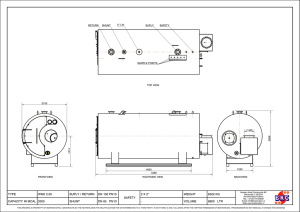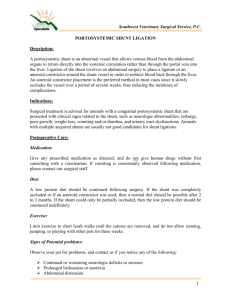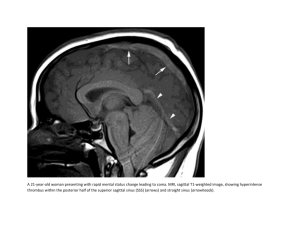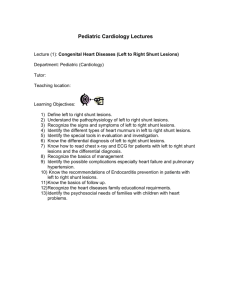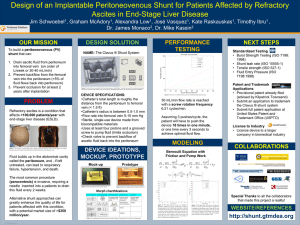Ventriculo-peritoneal shunts
advertisement
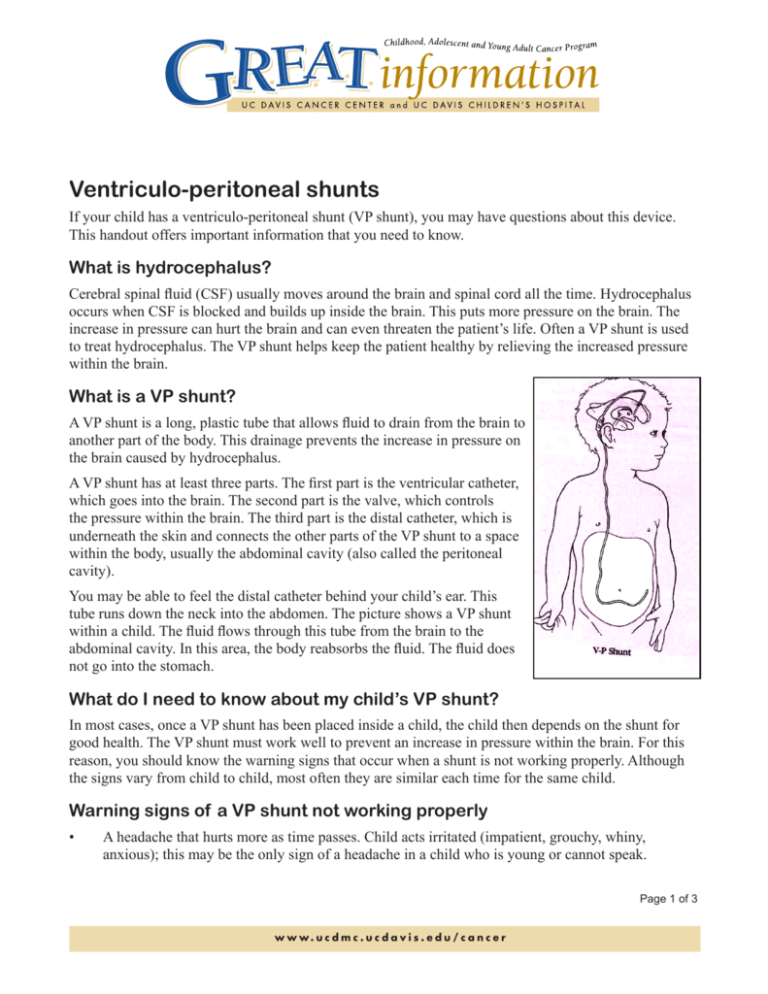
Ventriculo-peritoneal shunts If your child has a ventriculo-peritoneal shunt (VP shunt), you may have questions about this device. This handout offers important information that you need to know. What is hydrocephalus? Cerebral spinal fluid (CSF) usually moves around the brain and spinal cord all the time. Hydrocephalus occurs when CSF is blocked and builds up inside the brain. This puts more pressure on the brain. The increase in pressure can hurt the brain and can even threaten the patient’s life. Often a VP shunt is used to treat hydrocephalus. The VP shunt helps keep the patient healthy by relieving the increased pressure within the brain. What is a VP shunt? A VP shunt is a long, plastic tube that allows fluid to drain from the brain to another part of the body. This drainage prevents the increase in pressure on the brain caused by hydrocephalus. A VP shunt has at least three parts. The first part is the ventricular catheter, which goes into the brain. The second part is the valve, which controls the pressure within the brain. The third part is the distal catheter, which is underneath the skin and connects the other parts of the VP shunt to a space within the body, usually the abdominal cavity (also called the peritoneal cavity). You may be able to feel the distal catheter behind your child’s ear. This tube runs down the neck into the abdomen. The picture shows a VP shunt within a child. The fluid flows through this tube from the brain to the abdominal cavity. In this area, the body reabsorbs the fluid. The fluid does not go into the stomach. What do I need to know about my child’s VP shunt? In most cases, once a VP shunt has been placed inside a child, the child then depends on the shunt for good health. The VP shunt must work well to prevent an increase in pressure within the brain. For this reason, you should know the warning signs that occur when a shunt is not working properly. Although the signs vary from child to child, most often they are similar each time for the same child. Warning signs of a VP shunt not working properly • A headache that hurts more as time passes. Child acts irritated (impatient, grouchy, whiny, anxious); this may be the only sign of a headache in a child who is young or cannot speak. Page 1 of 3 w w w. u c d m c . u c d a v i s . e d u / c a n c e r Continued • Vomiting (throwing up) with little or no nausea (feeling sick to his or her stomach) • Not as alert. If you cannot wake your child, take him or her to the nearest emergency room right away, or call 911. • Changes in personality. For example, a child who is easy to deal with becomes very hard to handle all of a sudden or “ .. is just not acting right.” • Swelling of the skin that runs along the path of the VP shunt • A bulging soft spot on your child’s head • Vision problems (blurry or double vision, or loss of vision) • Loss of some mental and physical abilities that he or she had already mastered (milestones that fit your child’s age) These warning signs can appear quickly. For example, your child may appear fine one day, but the next day you may notice one or more of these signs. If you notice any of the warning signs above, call your child’s doctor or neurosurgeon right away (day or night). If you are on a vacation, you should call 911 or go to the nearest emergency room and tell them that your child has a shunt that might be broken. What is a shunt infection? A shunt infection occurs when bacteria infect the tissue around the VP shunt. When the tissue is infected, it can cause the VP shunt to stop working properly. A shunt that does not work well can cause an increase in pressure within the brain. This increase in pressure can damage the brain or threaten your child’s life. To help your child stay healthy, you should know the three signs of a shunt infection. Signs of a shunt infection • A fever that is equal to or higher than 100.4 degrees F (38.0 degrees C) • Redness or swelling of the skin that runs along the path of the VP shunt • Pain around the shunt or around the shunt tubing Please contact your child’s doctor, neurosurgeon or nurse right away if you suspect something might be wrong with the VP shunt. If you are on vacation, you should call 911 or go to the nearest emergency room and tell them that your child may have a shunt infection. Page 2 of 3 w w w. u c d m c . u c d a v i s . e d u / c a n c e r Continued What else do I need to know about my child’s VP shunt? Know the name of the neurosurgeon in your area who will take care of the VP shunt if it is not working properly. A neurosurgeon is a doctor who does brain surgery. Call the neurosurgeon or nurse from that office right away, if you see any signs of the shunt not working properly or a shunt infection. Know the name of the VP shunt that your child has. Carry in your wallet a small copy of the MR image or CT scan that was done when your child’s shunt was working properly. What do I need to know about long-term care of my child’s VP shunt? Children and teens who have VP shunts usually need them for the rest of their lives. The VP shunt can stop working well or become infected at any time during your child’s life. You must always look for the warning signs of these problems. Who must know that my child has a VP shunt? • Your child’s neurosurgeon or doctor: The neurosurgeon needs to check the VP shunt at least one time each year. This doctor will know what to do if the VP shunt stops working well or if the tissue around the shunt becomes infected. • Emergency services workers: Your child should always wear a MedicAlert® bracelet or necklace. If your child is ever seriously hurt and needs medical help, this bracelet or necklace will tell the emergency services workers that your child has a VP shunt. You can sign up for this type of bracelet or necklace at your local drug store. You can also visit the MedicAlert®Web site to find out more about their services (www.medicalert.com). • Someone living with or near the patient: When your child grows up and leaves home, it is crucial that at least one person who lives with or near your child knows that he or she has a VP shunt. It could be a close friend, a relative who lives near by, a co-worker or a neighbor. This person should learn the warning signs of a shunt that is not working well. Also, this person should agree to watch for these signs and, if they occur, to quickly seek medical help for your child. Keep in mind: Your child is shunt-dependent. This means that the VP shunt must work properly so that your child can stay healthy for the rest of his or her life. Adapted with permission from St. Jude Children’s Research Hospital. Revised 1/06 UC Davis Cancer Center 12/06 w w w. u c d m c . u c d a v i s . e d u / c a n c e r Page 3 of 3
